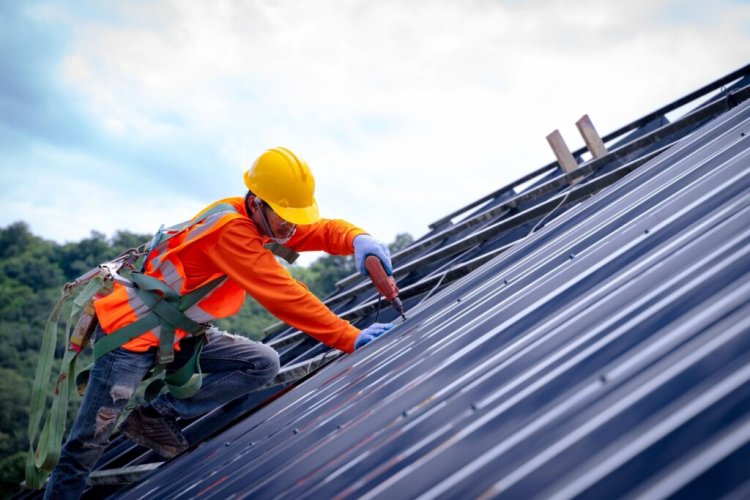Durable and Stylish Metal Roofing: The Ultimate Choice for Longevity and Performance
Discover the benefits of metal roofing, from unmatched durability to modern aesthetics. Learn about different metal roofing types, energy efficiency, and why it’s a top choice for homeowners and businesses.

When it comes to selecting a roofing material for your home or commercial building, durability and style are two of the most important factors to consider. Metal roofing has emerged as one of the top choices for homeowners, builders, and architects due to its long lifespan, energy efficiency, and modern aesthetic. Whether you’re looking to upgrade your existing roof or build a new structure, metal roofing offers unparalleled advantages over traditional materials like asphalt shingles or wood.
What is Metal Roofing?
Metal roofing refers to roofing systems made from various types of metal, including steel, aluminum, copper, and zinc. These roofs are typically designed in large panels or individual shingles, providing a sleek and modern appearance while offering superior protection against the elements.
Unlike traditional roofing materials, metal roofs are known for their strength, resistance to weather conditions, and minimal maintenance requirements. They can withstand harsh climates, including heavy rain, snow, high winds, and even fire.
Benefits of Metal Roofing
1. Exceptional Durability and Longevity
One of the standout features of metal roofing is its impressive lifespan. While asphalt shingle roofs last around 15–30 years, metal roofs can last anywhere from 40 to 70 years or more with proper maintenance. Certain metals, such as copper and zinc, can last well over 100 years, making them an incredibly long-lasting roofing solution.
2. Energy Efficiency and Sustainability
Metal roofs are highly energy-efficient due to their reflective properties. Unlike asphalt shingles that absorb heat, metal roofing reflects the sun’s rays, reducing heat absorption and keeping indoor spaces cooler. This reduces cooling costs by up to 25% during hot summers.
Additionally, metal roofing is an eco-friendly option. Most metal roofs are made from recycled materials, and they are 100% recyclable at the end of their life cycle. This reduces the amount of waste in landfills and minimizes environmental impact.
3. Superior Weather Resistance
Metal roofing is designed to withstand extreme weather conditions. Whether you live in an area prone to heavy snowfall, hurricanes, or wildfires, a metal roof can provide superior protection.
- Fire Resistance: Metal roofs are non-combustible and have a Class A fire rating, making them one of the safest roofing options available.
- Wind Resistance: Metal roofs can withstand wind speeds of 140 mph or more, making them ideal for areas prone to hurricanes or strong storms.
- Snow and Ice Shedding: In colder climates, metal roofing prevents snow and ice buildup by allowing it to slide off easily, reducing the risk of structural damage.
4. Low Maintenance Requirements
Unlike shingles, which can crack, curl, or require frequent replacement, metal roofs require minimal maintenance. Occasional inspections and basic cleaning are usually enough to keep a metal roof in excellent condition. Additionally, metal is resistant to mold, mildew, and insect damage, further reducing upkeep costs.
5. Stylish and Versatile Designs
Gone are the days when metal roofs were only associated with industrial buildings or barns. Today, metal roofing comes in a variety of styles, colors, and finishes to match any architectural design.
Some of the most popular styles include:
- Standing Seam Metal Roofing: A sleek, modern design with raised seams that enhance durability and water resistance.
- Metal Shingles: Designed to mimic the appearance of traditional roofing materials like wood, slate, or asphalt while offering superior durability.
- Corrugated Metal Panels: A cost-effective option commonly used in agricultural, industrial, and modern residential projects.
Whether you prefer a contemporary look or a more traditional aesthetic, there’s a metal roofing option to suit your style.
Types of Metal Roofing Materials
1. Steel Roofing
Steel is one of the most widely used materials for metal roofing due to its strength, affordability, and versatility. It is often coated with zinc (galvanized steel) or aluminum (Galvalume) to enhance its resistance to rust and corrosion.
2. Aluminum Roofing
Aluminum is lightweight, rust-resistant, and ideal for coastal areas where salt exposure can cause corrosion. While it is more expensive than steel, its durability and low maintenance requirements make it a great long-term investment.
3. Copper Roofing
Copper is known for its stunning appearance and ability to develop a natural patina over time. While it is one of the most expensive metal roofing options, it is also one of the most durable, often lasting over a century.
4. Zinc Roofing
Zinc is a premium roofing material that offers self-healing properties, meaning it can repair minor scratches over time. It is highly resistant to corrosion and requires little to no maintenance, making it a popular choice for high-end architectural projects.
Is Metal Roofing Right for You?
Metal roofing is an excellent choice for homeowners and business owners looking for a durable, stylish, and low-maintenance roofing solution. It offers long-term savings, increased energy efficiency, and enhanced protection against the elements.
However, it’s essential to consider factors such as initial cost, installation complexity, and noise levels (which can be mitigated with proper insulation). While the upfront investment may be higher than traditional roofing materials, the long-term benefits and durability make metal roofing a cost-effective choice in the long run.
Final Thoughts
Metal roofing is a smart investment that provides strength, style, and sustainability. Whether you're building a new home, upgrading your roof, or designing a commercial space, metal roofing offers long-lasting performance and modern aesthetics that stand the test of time.
What's Your Reaction?

















